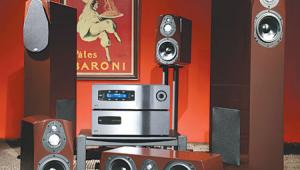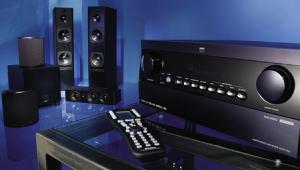Paradigm Cinema 330 Speaker System and Harman/Kardon AVR 340 A/V Receiver
It wasn't until I uncrated both the Paradigm Cinema 330 speakers and the Harman/Kardon AVR 340 receiver that I realized I'd found something rare in the home theater realm—a visual match between speakers and receiver. Did some invisible hand simultaneously guide Paradigm's whizzes in Toronto and Harman/Kardon's design squad in Northridge, California? These two large companies have no connection that I know of. Yet, this month's Spotlight System is a genuine fusion of Canadian and Californian design sensibilities.

That I am obsessing over the appearance of audio components indicates how far we've come. Any manufacturer who wants to ship units had better consider how their products will look in the home. In Paradigm's case, that means dispensing with the rectangular fiberboard enclosures that contribute to the superb performance of their more conventional products in favor of shapely molded plastic. The gray plastic is a close match for the suave gunmetal chassis of Harman/
Kardon's receiver. Accents of black—in the speaker grilles and the receiver's top-front panel—complete the resemblance. You'd almost swear that Dr. Sidney Harman and Scott Bagby sat down for a secret lunch and worked the whole thing out just to amaze the reviewer from Home Theater.
Three Tall Cool Ones
Three Paradigm Cinema 330 LCR speakers, a pair of Cinema ADP surrounds, and an UltraCube 10 subwoofer formed the speaker system. These models hail from the Monitor Series, which also includes several highly rated box-shaped speakers. The Cinema 330 is anything but boxy. It's more than 2 feet tall but not very wide or deep. The fluid-cooled PTD (pure titanium dome) tweeter gets pride of place in the center of the baffle, surrounded by a pair of ICP (injection-molded polypropylene-copolymer cone) midranges and a pair of polypropylene woofers. Visually, the speakers are spare, even austere, an impression the stand's skinny triangular column and glass base underscore.
 Unless you wall-mount them, the speakers need their stands, as they don't have a flat edge to rest upon. The mounting screws thread directly into the plastic enclosures, and their heads fit into cross-shaped holes on the stands. Access limitations may confront users of premium cable: Although the speakers have conventional plastic-nut binding posts, the stands block their banana-plug holes. You'll also need fairly slender cable to enter the column through a small hole and snake down to the base. That eliminated my bulky Monster 1.2 reference cable. Even my thinner Monster THX ribbon cable was too thick. Instead, I installed 12-gauge zip cord before I attached the speakers to the stands, grumbling about the unwelcome variable.
Unless you wall-mount them, the speakers need their stands, as they don't have a flat edge to rest upon. The mounting screws thread directly into the plastic enclosures, and their heads fit into cross-shaped holes on the stands. Access limitations may confront users of premium cable: Although the speakers have conventional plastic-nut binding posts, the stands block their banana-plug holes. You'll also need fairly slender cable to enter the column through a small hole and snake down to the base. That eliminated my bulky Monster 1.2 reference cable. Even my thinner Monster THX ribbon cable was too thick. Instead, I installed 12-gauge zip cord before I attached the speakers to the stands, grumbling about the unwelcome variable.
The Cinema 330s took up their positions below my Stewart FireHawk projection screen with a sleek patrician grace. Removing the grilles let me better appreciate the stylish radial grooves surrounding the tweeter, but leaving the grilles on imparted visual calm and subtlety. Company logos attach magnetically, and you can easily reposition them for vertical or horizontal placement.
The Cinema ADP dipole surrounds are the smallest I've seen outside of a compact sub/sat set. It's a sensible kind of reductionism, given the rarity of surround bass effects. Sonically, the Cinema ADPs are a fine match for the Cinema 330s. Wall-mount them, and you'll barely know they're there.
Tap either side of the UltraCube 10 subwoofer, and you'll feel a steel plate beneath each of the two 9-inch passive radiators. (The 10-inch high-excursion woofer is on the bottom.) This adds mass, which, in turn, lowers the divers' resonant frequency. It is slightly awe-inspiring to imagine the air pressures found within this small enclosure. The Class D amplifier is conservatively rated at 650 watts, a lot for a little sub. It sounds like a larger one.
An iPod Needs a Home
Harman/Kardon's AVR 340 A/V receiver continues the distinctive and elegant two-tone look of recent Harman/Kardon generations. Most of the controls are distributed across the panel within a skinny rectangular metal strip of buttons and rockers. These controls are wide enough to easily use, but they're not very tall, so they blend into the panel in a soothing manner. As a middle-of-the-line receiver, the AVR 340 offers a good combination of sophistication and value—along with the major advantages of Harman/Kardon's EzSet and room-equalization features. EzSet is a big deal, especially for newbies.
Besides providing a visual match for the speakers, the front panel also has a subtle inward curve on its bottom half that's inverted and is echoed in the arched shape of the Bridge. The latter, a $70 accessory, is Harman/Kardon's iPod-compatibility move. I plugged the small docking device into the back panel and positioned it atop my equipment rack, next to the turntable. (The intergenerational irony was duly noted.) That worked well for me, although some might prefer a front-panel docking jack.
Like very few other products, the Bridge does not require you to punch commands into the iPod (stressing its connectors). Instead, the player becomes a passive server that the receiver controls. That's the right way to do it! Choices abound: You may use either the receiver's front panel or your TV as the iPod display. And you may key in commands from the front panel or the remote.
Unlike the Denon S-301 HTIB, the Harman/Kardon does not mimic the look of the iPod display on your video display. What you'll see instead are two lines of information in white caps against a blue background. Dock the iPod, and source-select "The Bridge." With the remote in Bridge mode, its buttons duplicate familiar iPod commands. The menu button is helpfully adjacent to the left and right navigation keys, and the transport controls handle play, pause, stop, and track-skip functions.
I have some nits to pick. Harman/Kardon should add more lines to the onscreen display so that you can view artist, album, and song menus at least a half-dozen lines at a time (the more, the better). Also, nine rows of buttons that are irrelevant to the Bridge separate the remote's navigation controls from the transport keys. Making them adjacent would do no harm to the receiver's or the remote's other functions. By using the universal remote with the receiver, you might arrive at a more agreeable control layout. Still, once I had the hang of it, I was iPod-surfing my brains out.
With the high sensitivity of the Cinema 330s, the receiver was rarely (if ever) driven to clipping, and I used just a modest fraction of its volume capability.
Vasty Deep
The first order of business was to fine-tune the bass. Normally, I use personal default settings that work with my reference gear, as well as with much other equipment, and save the tweaking for later. Not this time. I couldn't set up the Paradigm UltraCube 10 in a quick-and-dirty way and ignore it for a while. Even with the receiver's low-frequency-effects level set at the absolute minimum, the sub was still too strong. Hairline adjustments of the sub volume control—which really needs more degrees of adjustment at its bottom end—eventually got the proportions right. The good news here is that this sub has far greater volume capability than I expected. Once you get it dialed in, you'll be awestruck.
That's good, since bass is not the Cinema 330's strong suit. Played full-range, it leans to the light side, more like a compact satellite than something 2 feet tall. I increased my usual 80-hertz crossover to 100 Hz and later to 120 Hz. This made the UltraCube 10 an even bigger player in the scheme of things. And it stepped right up to bat, smacking tuneful grooves out of the ballpark and sensitively sculpting orchestral bass sections and timpani.
The Cinema 330s are voiced to sit on or near walls. In my usual 2-feet-out position, they were bright but improved a little when I moved them closer to the wall. They had a way of strongly outlining sonic objects. For instance, in Donald Fagen's Morph the Cat, the speakers gave brass arrangements a stinging edge and downplayed the crushed-velvet inner texture of the lead vocal.
Musically, they were more at home with June Tabor's At the Wood's Heart, which is less like a cartoon and more like an exquisite woodcut. Like most of the English-traditional singer's long discography, this new release suspends the precise enunciation of her distinctively husky contralto in vast pools of quiet space only slightly filled in by her usual collaborators on piano, viola, guitar, and other instruments. Here, the outlining acquired delicacy. And, with so many open spaces in the mix, the Paradigms more easily brought out the vocal timbre and small dynamic shifts.
Deadwing by Porcupine Tree entered my system through the front door—with a great DVD-Audio mix, complemented by a DTS alternate soundtrack, and supplemented with three DTS-only bonus tracks. The main use of the surround channels on this disc is to add enough ambience to bring most elements of the front soundstage a foot or two in front of the speakers and slightly farther forward at the sides. A few details found their way into the surrounds, but I never felt that the surrounds were being overused, partly because the Cinema ADP's dipole design created a null in the listening area, keeping effects diffuse and keeping attention in the front where it belongs. The UltraCube 10 made the rhythm section a precisely pitched and focused treat.
Kong, Casanova, and the Gardener
The first movie I watched was King Kong. Unfortunately, this was before I dialed in the bass, and the overall effect was the sonic equivalent of dodgeball. Remote in hand, I kept dodging, knocking down the master volume. But no matter how low it went, dialogue was perfectly intelligible.
By the time I got to the Venetian Carnavale of Casanova, with fireworks exploding, the sub was right in the pocket. The detonations were extremely lifelike—distant yet palpably solid—and Heath Ledger's seductive drawl was as colorful as the fireworks. The dominant element of this soundtrack, however, is the score, in which bits of Vivaldi and other baroque composers are cleverly blended with newly written pastiche, all of it recorded with a roomy ambience reminiscent of a Venetian palazzo.
An early airport scene in The Constant Gardener had me wondering where the airplane noise was coming from. I do live along the Hudson River flight path. I reverse-scanned a small amount and replayed the scene. The sound came from the speakers and sub. This latter-day John Le Carré thriller came with a relatively nonstereotypical soundtrack, a melange of varied world-beat-ish music and realistic (as opposed to overdone) effects. The sub brought home the moments of low-frequency menace, while the Cinema 330 that was serving as the center speaker helpfully picked out whispered and low-voiced dialogue. The overall experience was more moving than average demo material.
Here's a short list of this system's strengths: Truly satisfying bass in a small package, iPod compatibility with a better-than-average user interface, effortless vocal intelligibility, power of high quality and more than sufficient quantity, and a blessedly unified décor friendliness. In bits and pieces, these are not exactly rare jewels, but it was a pleasure to have them all together in the same place at the same time.
Audio editor Mark Fleischmann is also the author of the annually updated book Practical Home Theater (www.quietriverpress.com).
- Log in or register to post comments






















































